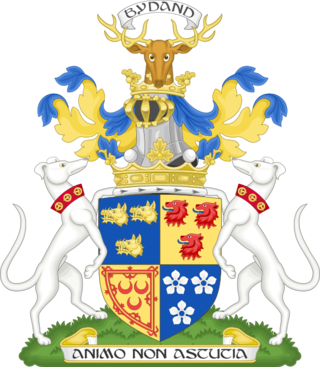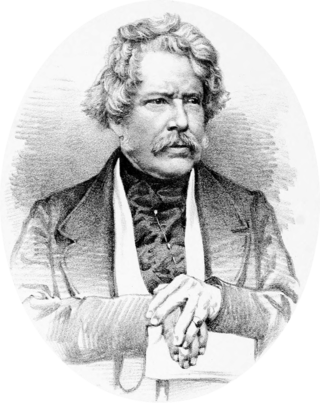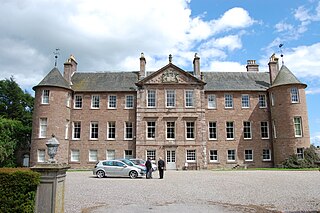
Marquess of Huntly is a title in the Peerage of Scotland that was created on 17 April 1599 for George Gordon, 6th Earl of Huntly. It is the oldest existing marquessate in Scotland, and the second-oldest in the British Isles; only the English marquessate of Winchester is older. The Marquess holds the following subsidiary titles: Lord Gordon of Strathaven and Glenlivet and Earl of Aboyne, and Baron Meldrum, of Morven in the County of Aberdeen.

Earl of Shrewsbury is a hereditary title of nobility created twice in the Peerage of England. The second earldom dates to 1442. The holder of the Earldom of Shrewsbury also holds the title of Earl of Waterford (1446) in the Peerage of Ireland and Earl Talbot (1784) in the Peerage of Great Britain. Shrewsbury and Waterford are the oldest earldoms in their peerages held by someone with no higher title, and as such the Earl of Shrewsbury is sometimes described as the premier earl of England and Ireland.

Earl of Devon was created several times in the English peerage, and was possessed first by the de Redvers family, and later by the Courtenay family. It is not to be confused with the title of Earl of Devonshire, held, together with the title Duke of Devonshire, by the Cavendish family of Chatsworth House, Derbyshire, although the letters patent for the creation of the latter peerages used the same Latin words, Comes Devon(iae). It was a re-invention, if not an actual continuation, of the pre-Conquest office of Ealdorman of Devon.

The title Earl of Morton was created in the Peerage of Scotland in 1458 for James Douglas of Dalkeith. Along with it, the title Lord Aberdour was granted. This latter title is the courtesy title for the eldest son and heir to the Earl of Morton.

Earl of Dalhousie, in the County of Midlothian, is a title in the Peerage of Scotland, held by the Chief of Clan Ramsay.

Earl of Southesk is a title in the Peerage of Scotland. It was created in 1633 for Sir David Carnegie, an Extraordinary Lord of Session. He had already been created Lord Carnegie of Kinnaird in 1616 and was made Lord Carnegie, of Kinnaird and Leuchars, at the same time he was given the earldom. These titles are also in the Peerage of Scotland. The earldom is named after the River South Esk in Angus. Carnegie's younger brother John Carnegie was given the corresponding title: earl of Northesk. The earl of Southesk also holds the Scottish feudal title of Baron of Kinnaird and is a baronet in the Baronetage of Nova Scotia. Kinnaird Castle, Brechin, has been the home of the earls of Southesk for several hundred years.

Baron Kilmarnock, of Kilmarnock in the County of Ayr, Scotland, is a title in the Peerage of the United Kingdom. It was created in 1831 for William Hay, 18th Earl of Erroll. This was a revival of the Kilmarnock title held by his great-grandfather William Boyd, 4th Earl of Kilmarnock, who was attainted in 1746. The barony of Kilmarnock remained a subsidiary title of the earldom of Erroll until the death in 1941 of the eighteenth Earl's great-great-grandson, the twenty-second Earl. The earldom, which could be passed on through female lines, was inherited by the late Earl's daughter and only child, the twenty-third Countess. The barony of Kilmarnock, which could only be passed on to male heirs, was inherited by the Earl's younger brother, the sixth Baron. He assumed the surname of Boyd in lieu of Hay the same year he succeeded to the title. As of 2013 the title is held by his younger son, the eighth Baron, who succeeded his elder brother in 2009.

The title Earl Fife was a title in the Peerage of Ireland created by letters patent dated 26 April 1759 for William Duff (1696–1763) after asserting his descent from Macduff, the medieval Earl of Fife. Though in the Irish peerage, the title implies a connection with Fife in Scotland.

Earl of Seaforth was a title in the Peerage of Scotland and the Peerage of Ireland. It was held by the family of Mackenzie from 1623 to 1716, and again from 1771 to 1781.

The title Earl of Carnwath is a title in the Peerage of Scotland, created together with the subsidiary title of Lord Dalzell and Liberton, on 21 April 1639 for Robert Dalzell, 2nd Lord Dalzell. His father, Sir Robert Dalzell, had been raised to the Peerage as a Lord of Parliament when he was created Lord Dalzell on 18 September 1628, also in the Peerage of Scotland. The titles refer to Carnwath in Lanarkshire, and Liberton in Edinburgh. The surname of Dalzell is pronounced dee-EL.

Fox Maule-Ramsay, 11th Earl of Dalhousie,, known as Fox Maule before 1852, as The Lord Panmure between 1852 and 1860, was a British politician.
George Ramsay, 8th Earl of Dalhousie was a Scottish peer. He served as a Lord of Police (1775–82) and the Lord High Commissioner to the General Assembly of the Church of Scotland, and was a representative Scottish peer (1774–1787).

William Ramsay Maule, 1st Baron Panmure of Brechin and Navar was a Scottish landowner and politician.

Lieutenant-General Charles Butler, 1st Earl of Arran, de jure3rd Duke of Ormonde (1671–1758) was an Anglo-Irish peer. His uncle Richard was the 1st Earl of Arran of the first creation. The titles were re-created for Charles in 1693. His elder brother, the 2nd Duke of Ormonde, was attainted during the Jacobite rising of 1715, but in 1721 Arran was allowed to buy the estate back. At the death of the 2nd Duke, he succeeded as de jure 3rd Duke of Ormonde in the Irish peerage but did not claim the title.
Baron Panmure, of Brechin and Navar in the County of Forfar, was a title in the Peerage of the United Kingdom. The barony was created on 10 September 1831 for the Hon. William Maule, longtime Member of Parliament for Forfar. On the death of William Ramsay in 1852 the title passed to his eldest son Fox Maule-Ramsay, and became extinct in 1874 on his death.

General William Maule, 1st Earl Panmure (1700–1782) was a Scottish soldier and politician who sat in the House of Commons for 47 years from 1735 to 1782.
Sir Henry Maule was the son and heir of Sir William Maule, Baron of Panmure and Benvie and Ethana de Vallibus, daughter of John Vaux, Lord of Dirleton. Henry succeeded as Baron on his father's death and was married to Margaret Hay, daughter of Sir William Hay of Locherworth.
James Drummond, 1st Baron Perth, was a Scottish soldier, landowner and peer.

James Livingston, 5th Earl of Linlithgow, 4th Earl of Callendar was a Scottish nobleman who was convicted of high treason and forced to forfeit his estates and all his titles to the Crown.

Earl of Arran is a title in the Peerage of Ireland. It is not to be confused with the title Earl of Arran in the Peerage of Scotland. The two titles refer to different places: the Aran Islands in Ireland, and the Isle of Arran in Scotland. The Irish earldom is held by the Gore family. The Scottish earldom is a separate title, held as a subsidiary title of the Duke of Hamilton.









